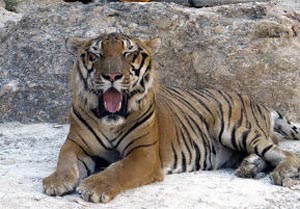Linked with Abbot-Pra Acharn Phusit (Chan) Khantitharo – Thailand.
Brief history of the temple: In 1985, Pra Achan Phusit (Chan) Khantitharo (presently, he’s the abbot of Wat Pa Luangta Bua Yansampanno Forest Monastery) traveled on foot into the forest in Kanchanaburi. He then practiced Dhamma at the cave (the present location of Wat Pa Tham Phu Toei), around 3 km from Phu Toei village. At that time, there were only 21 households. He started building chamber, pavilion, storage pond, school, and did the teaching. The purpose was to instill Dhamma into the mind of the youths, even living in the remote forest, which would lead to a peaceful society. While he was there, hardly anyone knew that he was a disciple of Venerable Luangta Maha Bua. It was until in 1994 when Luangta Maha Bua ordered him to build Wat Pa Luangta Bua Forest Monastery that he had to leave Wat Pa Tham Phu Toei. He appointed Pra Achan Sunthorn (Uan) Khamphirapanyo as the abbot up to now. However, he took his disciples to present robes to monks at his previous monastery regularly every year. Since this monastery is very far away and the route is still not very convenient. It’s necessary to make the trip in advance to stay overnight and present robes the next morning. We crossed Sri Nakharin Dam by ferry. Upon arrival, the villagers there took us to visit the cave. (full text).

The guest book of the tiger temple.
The forest monastery of Wat Pa Luangta Bua Yannasampanno, known internationally as Tiger Temple , was built in 1994 after a Buddhist woman donated 275 acres of land for the project – its objectives were to propogate Buddhism and to conserve forests and wildlife. It started as a temple and meditation centre, run by today’s abbot, Pra Acharn Phusit (Chan), and it was named after Abbot Phusit’s teacher, a highly respected and well-known meditation guru. (full text).
See much more about this temple in Abbot-Pra Acharn Phusit‘s presentation.
